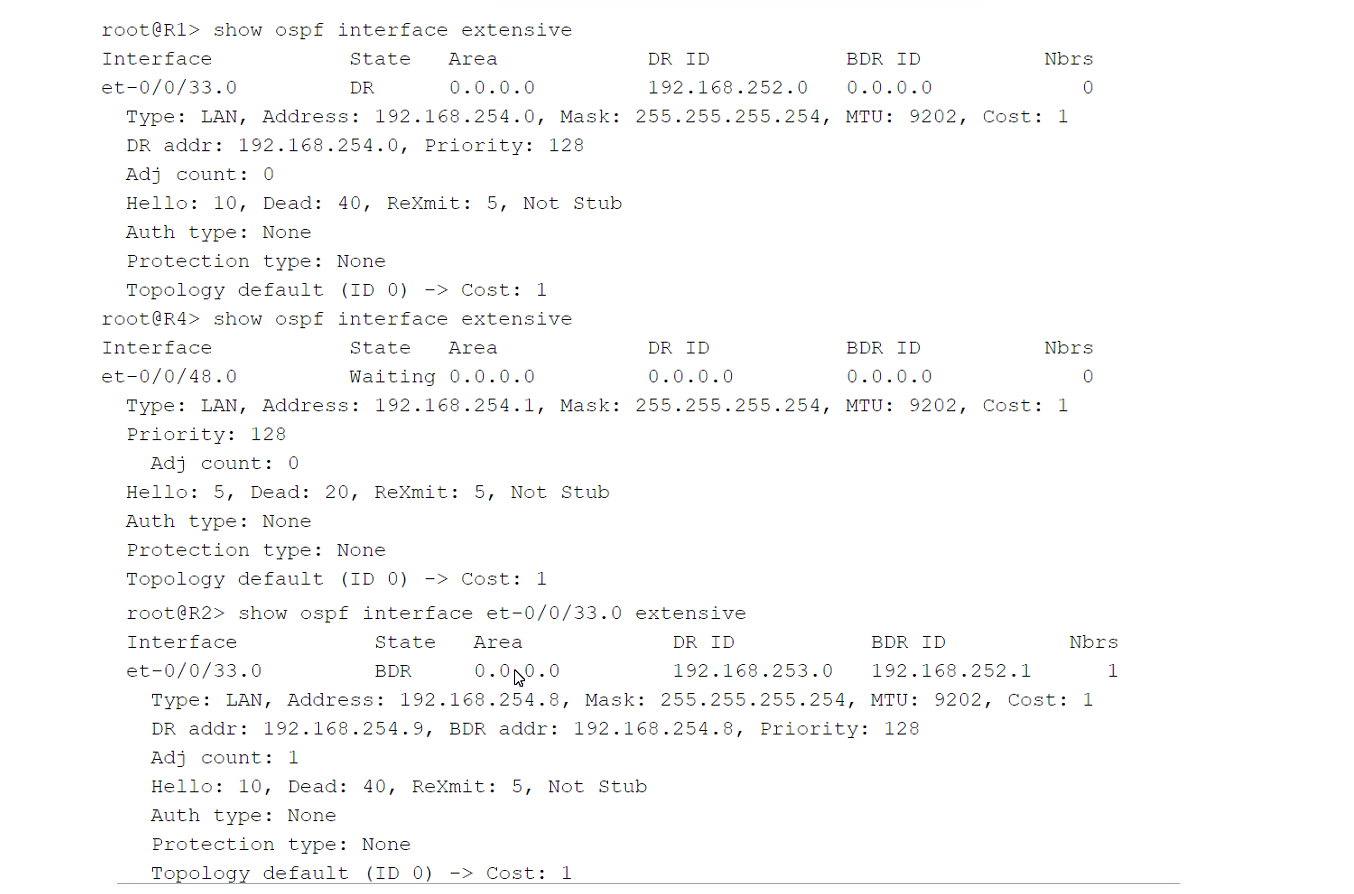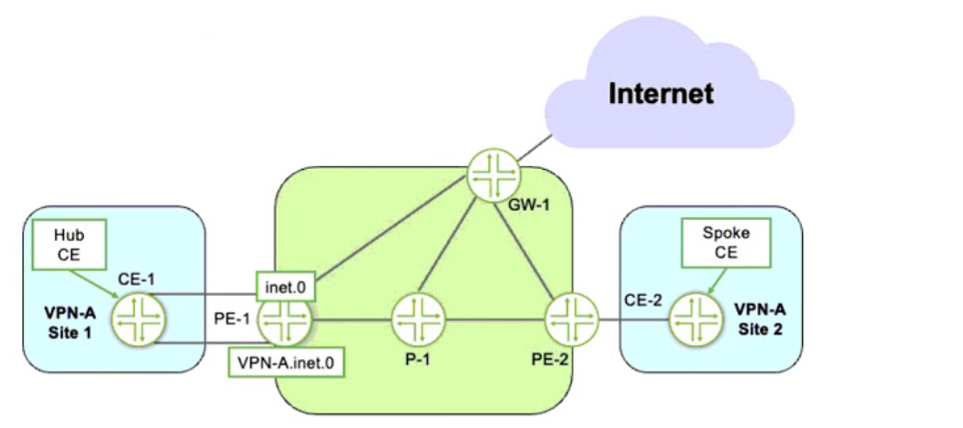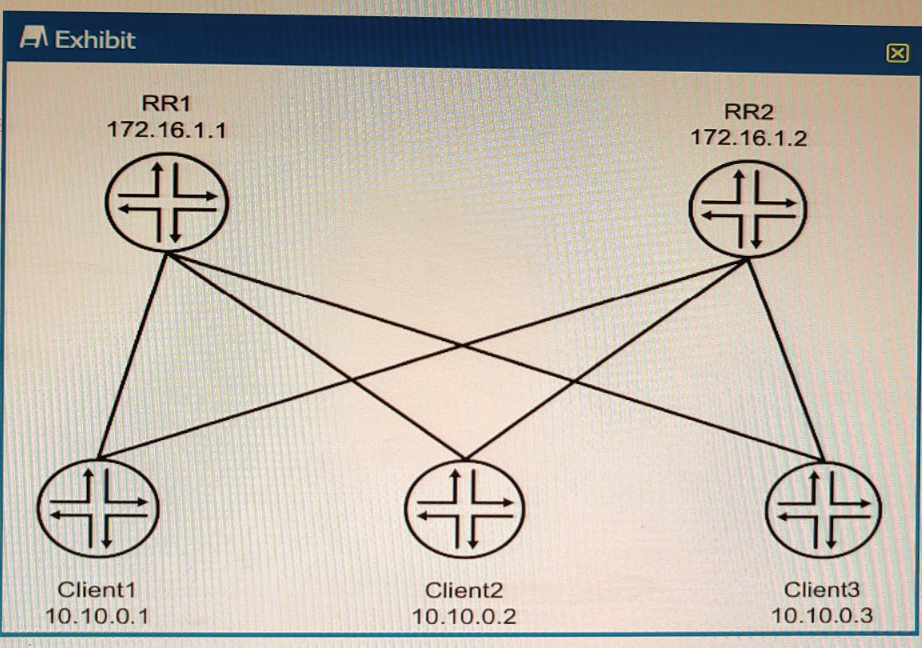You are configuring a BGP signaled Layer 2 VPN across your MPLS enabled core network. Your PE-2 device connects to two sites within the s VPN
In this scenario, which statement is correct?
A. By default on PE-2, the site's local ID is automatically assigned a value of 0 and must be configured to match the total number of attached sites.
B. You must create a unique Layer 2 VPN routing instance for each site on the PE-2 device.
C. You must use separate physical interfaces to connect PE-2 to each site.
D. By default on PE-2, the remote site IDs are automatically assigned based on the order that you add the interfaces to the site configuration.
In IS-IS, which two statements are correct about the designated intermediate system (DIS) on a multi-access network segment? (Choose two)
A. A router with a priority of 10 wins the DIS election over a router with a priority of 1.
B. A router with a priority of 1 wins the DIS election over a router with a priority of 10.
C. On the multi-access network, each router forms an adjacency to every other router on the segment
D. On the multi-access network, each router only forms an adjacency to the DIS.
You are configuring anycast RP for load balancing and redundancy in your PIM-SM domain. You want to share active sources between RPs.
In this scenario, what are two solutions that will accomplish this task? (Choose two.)
A. Configure MSDP on each RP router.
B. Configure anycast PIM with the rp-set statement on each RP router.
C. Configure anycast PIM with the rp-set statement on each source DR router.
D. Configure MSDP on each source DR router.
In IS-IS, which two statements are correct about the designated intermediate system (DIS) on a multi-access network segment? (Choose two)
A. A router with a priority of 10 wins the DIS election over a router with a priority of 1.
B. A router with a priority of 1 wins the DIS election over a router with a priority of 10.
C. On the multi-access network, each router forms an adjacency to every other router on the segment
D. On the multi-access network, each router only forms an adjacency to the DIS.
Which two statements are correct regarding the PIM DR in a PIM-SM domain? (Choose two.)
A. The source DR sends PIM register messages from the source network to the RP.
B. If the DR priorities match, the router with the lowest IP address is selected as the DR.
C. The receiver DR sends PIM join and PIM prune messages from the receiver network toward the RP.
D. By default, PIM DR election is performed on point-to-point links.

Click the Exhibit button.
You have an OSPF environment. You have recently added a router called R4 that is
directly connected to R1 and R2. You discover that R4 is only peering with R2.
Referring to the exhibit, how would you correct the peering?
A. Adjust the Priority on R1 to be lower than the Priority on R4.
B. Change the MTU size on R1 and R2 to be 22 bytes higher than R4's MTU size.
C. Adjust the Dead Interval on R4 to match the Dead Interval on R1 and R2.
D. Adjust the Hello Interval on R1 and R2 to match the Hello Interval on R4.
Exhibit

Referring to the exhibit, you must provide Internet access for VPN-A using CE-1 as the hub
CE.
Which two statements are correct in this situation? (Choose two.)
A. You must use RIB groups to leak routes between the inet. o and vpn-a. inet. o tables.
B. RIB groups are not needed to leak routes between the inet. 0 and VPN—A. inet. 0 tables,
C. Internet traffic from Site 2 takes the path of PE-2 -> PE-1 -> GW-1.
D. Internet traffic from Site 2 takes the path of PE-2 -> PE-1 -> CE-1 -> PE-1 -> GW-1.
A router running IS-IS is configured with an ISO address of 49.0001.00a0.c96b.c490.00.
Which part of this address is the system ID?
A. 00a0.c96b.c490 is the system identifier.
B. 0001.00a0.c96b.c490 is the system identifier.
C. c96b.c490 is the system identifier.
D. c490 is the system identifier.
Explanation:
In IS-IS (Intermediate System to Intermediate System) routing, each router is identified by a
unique ISO (International Organization for Standardization) address, also known as a
Network Entity Title (NET). The NET consists of three parts:
1. **Area Identifier**: Indicates the area to which the router belongs.
2. **System Identifier**: Uniquely identifies the router within the area.
3. **NSAP Selector (NSEL)**: Typically set to 00 for a router, indicating the Network
Service Access Point.
The format of the ISO address is `49.XXXX.YYYY.YYYY.ZZZZ.ZZZZ.00`, where:
- `49` is the AFI (Authority and Format Identifier) indicating a private address.
- `XXXX` is the Area Identifier.
- `YYYY.YYYY.YYYY` is the System Identifier.
- `ZZZZ.ZZZZ` is the NSAP Selector.
Given the address `49.0001.00a0.c96b.c490.00`:
- **Area Identifier**: `49.0001`
- **System Identifier**: `00a0.c96b.c490`
- **NSAP Selector**: `00`
**Explanation**:
- **A. 00a0.c96b.c490 is the system identifier**:
- Correct. The System Identifier in an ISO address is a 48-bit (6-byte) field used to uniquely
identify the router. In this address, `00a0.c96b.c490` is the correct 6-byte System Identifier.
- **B. 0001.00a0.c96b.c490 is the system identifier**:
- Incorrect. This includes the Area Identifier as part of the System Identifier, which is not
correct.
- **C. c96b.c490 is the system identifier**:
- Incorrect. This is only part of the System Identifier. The full System Identifier must be 6
bytes long.
- **D. c490 is the system identifier**:
- Incorrect. This is an incomplete and incorrect part of the System Identifier.
**Conclusion**:
The correct part of the address that represents the System Identifier is:
**A. 00a0.c96b.c490 is the system identifier.**
Exhibit

The environment is using BGP All devices are in the same AS with reachability redundancy
Referring to the exhibit, which statement is correct?
A. RR1 is peered to Client2 and RR2
B. RR2 is in an OpenConfirm State until RR1 becomes unreachable.
C. Client1 is peered to Client2 and Client3.
D. Peering is dynamically discovered between all devices.
Explanation: BGP route reflectors are BGP routers that are allowed to ignore the IBGP
loop avoidance rule and advertise IBGP learned routes to other IBGP peers under specific
conditions. BGP route reflectors can reduce the number of IBGP sessions and updates in a
network by eliminating the need for a full mesh of IBGP peers. BGP route reflectors can
have three types of peerings:
EBGP neighbor: A BGP router that belongs to a different autonomous system (AS)
than the route reflector.
IBGP client neighbor: An IBGP router that receives reflected routes from the route
reflector. A client does not need to peer with other clients or non-clients
.
IBGP non-client neighbor: An IBGP router that does not receive reflected routes
from the route reflector. A non-client needs to peer with other non-clients and the
route reflector.
In the exhibit, we can see that RR1 and RR2 are route reflectors in the same AS with
reachability redundancy. They have two types of peerings: EBGP neighbors (R1 and R4)
and IBGP client neighbors (Client1, Client2, and Client3). RR1 and RR2 are also peered
with each other as IBGP non-client neighbors.
Your organization manages a Layer 3 VPN for multiple customers To support advanced
route than one BGP community on advertised VPN routes to remote PE routers.
Which routing-instance configuration parameter would support this requirement?
A. vrf-export
B. vrf-import
C. vrf-target export
D. vrf-target import
Explanation: The vrf-target statement is used in routing-instances to define routetarget
communities for VPN route import and export policies.
vrf-target export Controls which route targets (RTs) are added to advertised
routes (used when sending routes to remote PEs).
vrf-target import Controls which VPN routes are accepted into the VRF (used
when receiving routes from remote PEs).
Exhibit
user@Rl show configuration interpolated-profile { interpolate {
fill-level [ 50 75 drop—probability [ > }
class-of-service drop-profiles
];
20 60 ];
Which two statements are correct about the class-of-service configuration shown in the
exhibit? (Choose two.)
A. The drop probability jumps immediately from 20% to 60% when the queue level reaches 75% full.
B. The drop probability gradually increases from 20% to 60% as the queue level increases from 50% full to 75% full
C. To use this drop profile, you reference it in a scheduler.
D. To use this drop profile, you apply it directly to an interface.
Explanation: class-of-service (CoS) is a feature that allows you to prioritize and manage
network traffic based on various criteria, such as application type, user group, or packet
loss priority. CoS uses different components to classify, mark, queue, schedule, shape, and
drop traffic according to the configured policies.
One of the components of CoS is drop profiles, which define how packets are dropped
when a queue is congested. Drop profiles use random early detection (RED) algorithm to
drop packets randomly before the queue is full, which helps to avoid global synchronization
and improve network performance. Drop profiles can be discrete or interpolated. A discrete
drop profile maps a specific fill level of a queue to a specific drop probability. An
interpolated drop profile maps a range of fill levels of a queue to a range of drop
probabilities and interpolates the values in between.
In the exhibit, we can see that the class-of-service configuration shows an interpolated drop
profile with two fill levels (50 and 75) and two drop probabilities (20 and 60). Based on this
configuration, we can infer the following statements:
The drop probability jumps immediately from 20% to 60% when the queue level
reaches 75% full. This is not correct because the drop profile is interpolated, not
discrete. This means that the drop probability gradually increases from 20% to
60% as the queue level increases from 50% full to 75% full. The drop probability
for any fill level between 50% and 75% can be calculated by using linear
interpolation formula.
The drop probability gradually increases from 20% to 60% as the queue level
increases from 50% full to 75% full. This is correct because the drop profile is
interpolated and uses linear interpolation formula to calculate the drop probability
for any fill level between 50% and 75%. For example, if the fill level is 60%, the
drop probability is 28%, which is calculated by using the formula: (60 - 50) / (75 -
50) * (60 - 20) + 20 = 28.
To use this drop profile, you reference it in a scheduler. This is correct because a
scheduler is a component of CoS that determines how packets are dequeued from
different queues and transmitted on an interface. A scheduler can reference a drop
profile by using the random-detect statement under the [edit class-of-service
schedulers] hierarchy level. For example: scheduler test { transmit-rate percent 10;
buffer-size percent 10; random-detect test-profile; }
To use this drop profile, you apply it directly to an interface. This is not correct
because a drop profile cannot be applied directly to an interface. A drop profile can
only be referenced by a scheduler, which can be applied to an interface by using
the scheduler-map statement under the [edit class-of-service interfaces] hierarchy
level. For example: interfaces ge-0/0/0 { unit 0 { scheduler-map test-map; } }
Exhibit

Referring to the exhibit, a working L3VPN exists that connects VPN-A sites CoS is
configured correctly to match on the MPLS EXP bits of the LSP, but when traffic is sent
from Site-1 to Site-2, PE-2 is not classifying the traffic correctly
What should you do to solve the problem?
A. Configure the explicit-null statement on PE-1.
B. Configure the explicit-null statement on PE-2
C. Configure VPN prefix mapping for the PE-1_to_PE-2 LSP
D. Set a static CoS value for the PE-1_to_PE-2 LSP
Explanation: Understanding the Problem in MPLS CoS Classification
How EXP Bits Are Used for CoS in MPLS
What Happens with PHP (Penultimate Hop Popping)?
Solution: Configure Explicit-Null on PE-2
Evaluating the Answer Choices Again
B. Configure the explicit-null statement on PE-2.
Correct, because:
set protocols mpls explicit-null
uk.co.certification.simulator.questionpool.PList@2cf90c42
"Explicit-null must be configured on the egress LSR to prevent PHP from removing the top
MPLS label, thereby preserving the EXP bits."
A. Configure the explicit-null statement on PE-1.
Incorrect, because:
C. Configure VPN prefix mapping for the PE-1_to_PE-2 LSP.
Incorrect, because:
D. Set a static CoS value for the PE-1_to-PE-2 LSP.
Incorrect, because:
Final Answer: B. Configure the explicit-null statement on PE-2.
Key Takeaways
Penultimate Hop Popping (PHP) removes the outer MPLS label at P-1, which also
removes the EXP bits used for CoS classification.
To keep EXP bits intact, configure explicit-null on the egress PE (PE-2).
This forces P-1 to send a label (0 for IPv4, 2 for IPv6) to PE-2, preserving the EXP
bits for CoS classification.
Official Juniper Documentation Reference
Juniper MPLS CoS and PHP Behavior Guide
"To retain CoS EXP bits at the egress LSR, configure explicit-null on the egress PE. This
prevents PHP from stripping the MPLS label before reaching the final PE router."
| Page 3 out of 9 Pages |
| Previous |